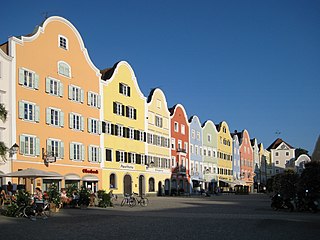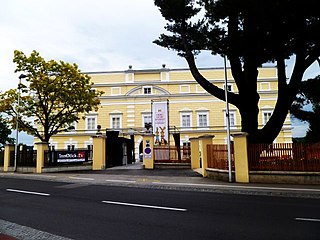
Auerbach is a town in Upper Austria, Austria. Its length from north to south is 4.3 km and from east to west is 5 km; its area is 10.78 km2. In 2015, it had 565 inhabitants.

Ried im Innkreis is a town in the Austrian state of Upper Austria, approximately 70 km (43 mi) west of Linz and 60 km (37 mi) north of Salzburg. It is the capital of the district of Ried im Innkreis, and it serves as the administrative centre for the Innviertel region.

Schärding is a town in the northern Austrian state of Upper Austria, the capital of the district of the same name, and a major port on the Inn River. Historically, it was owned by the Wittelsbach family, which is reflected in the town's architecture.
Hohenzell is a municipality in Upper Austria. It is situated in the district of Ried im Innkreis in the Innviertel and has 2,002 inhabitants. The responsible jurisdiction is Ried im Innkreis.

Neuhofen im Innkreis is a municipality in Upper Austria in the district of Ried im Innkreis.

Tarsdorf is a municipality in the district of Braunau am Inn in the Austrian state Upper Austria.

Hochburg-Ach is a municipality in the district of Braunau am Inn in the Austrian state of Upper Austria.

Mattighofen is a town in the district of Braunau am Inn, part of the Innviertel region, in the Austrian state of Upper Austria.

Ostermiething is a municipality in the district of Braunau am Inn in the Austrian state of Upper Austria.

St. Pantaleon is a municipality in the Braunau district in Upper Austria, Austria. A monument was erected by the riverlet Moosach in memory of the slave workers engaged there in 1940/41 at the Weyer concentration camp.

St. Radegund is a municipality in the district of Braunau in the Austrian state of Upper Austria, named after Saint Radegund. It is situated at the western rim of the Innviertel region, where the Salzach river forms the border to the German state of Bavaria.

Eitzing is a municipality in the district of Ried im Innkreis in the Austrian state of Upper Austria.

St. Martin im Innkreis is a municipality in Ried District, in the Austrian state of Upper Austria.

Andorf is a municipality in the district of Schärding in Upper Austria, Austria. As of 2024, it had a population of 5,218.

Engelhartszell an der Donau is a municipality in the district of Schärding in the Austrian state of Upper Austria.

Enzenkirchen is a municipality in the district of Schärding in the Austrian state of Upper Austria.

Sankt Willibald, officially St. Willibald, is a municipality in the district of Schärding in the Austrian state of Upper Austria.

Schardenberg is a municipality in the district of Schärding in the Austrian state of Upper Austria.

Vichtenstein is a municipality in the district of Schärding in the Austrian state of Upper Austria.

Wernstein am Inn is a municipality in the district of Schärding in the Austrian state of Upper Austria.






















